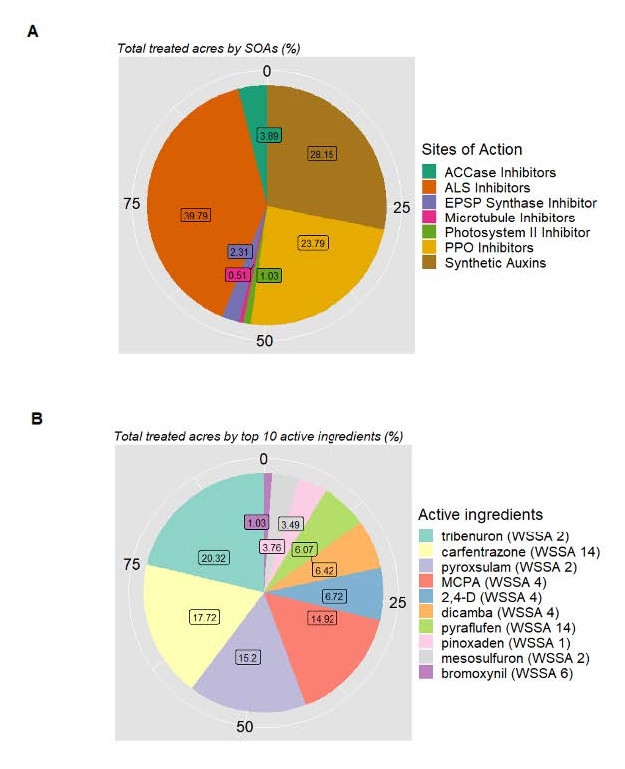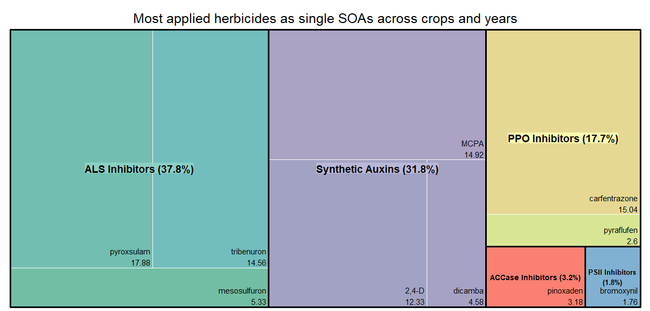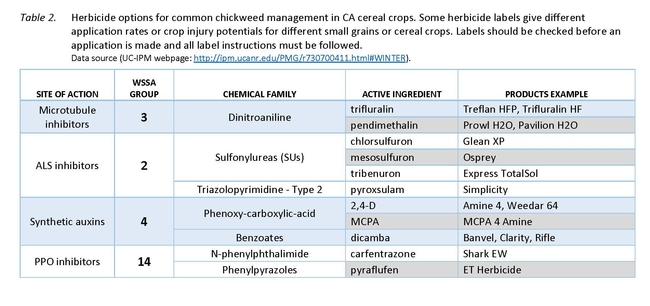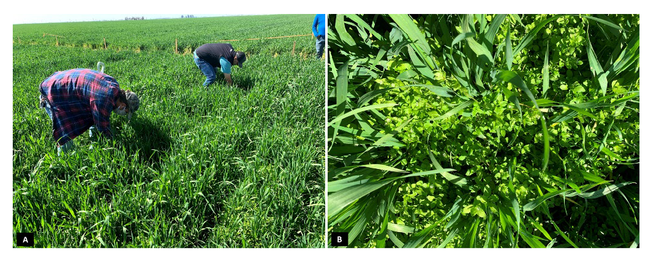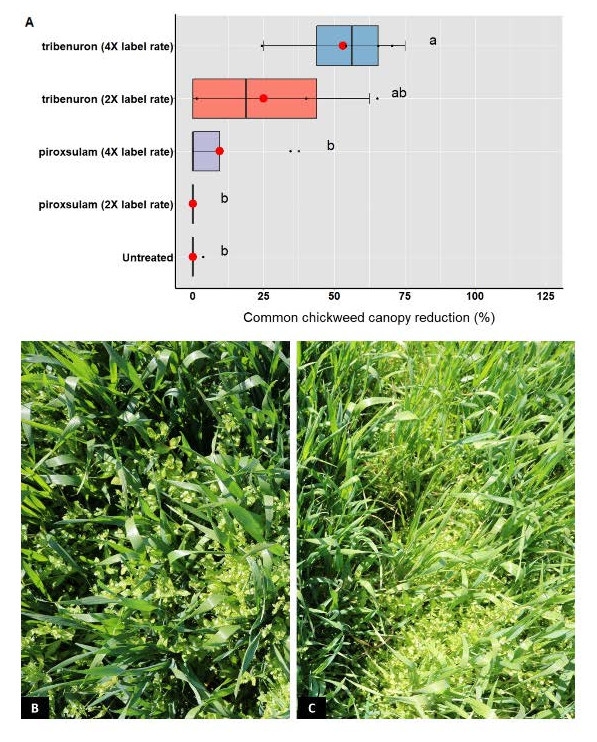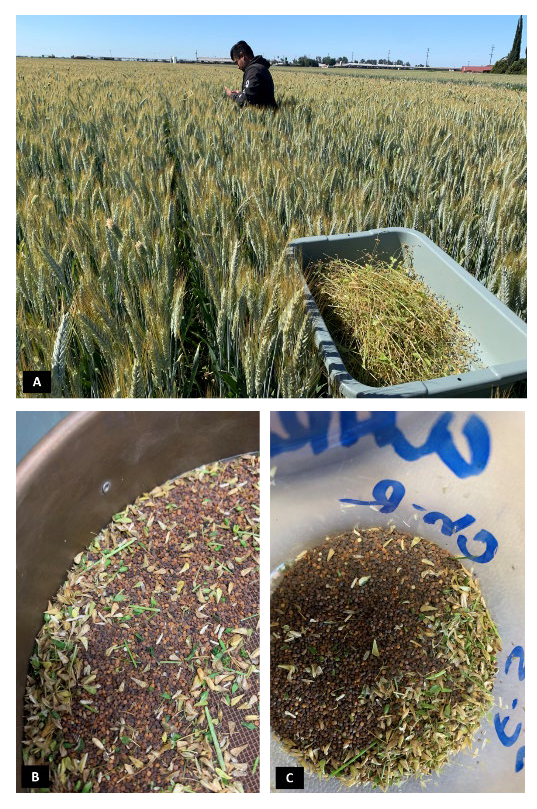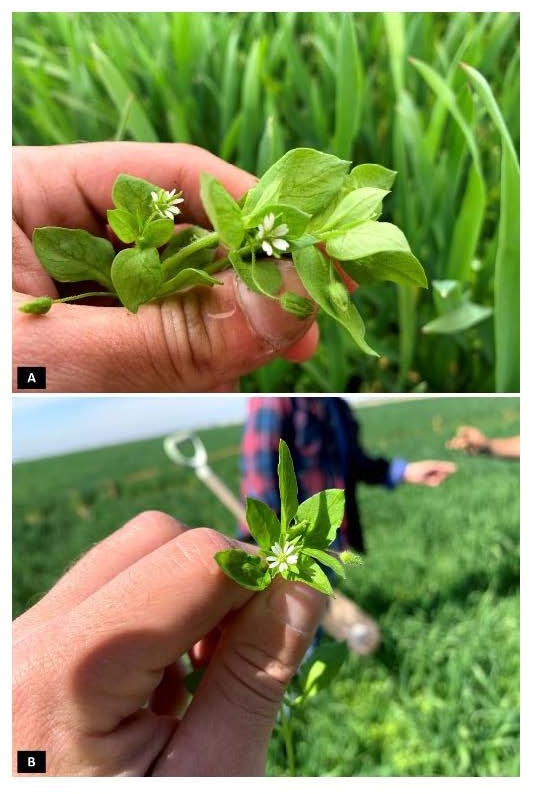
Common chickweed biology and competitiveness
Common chickweed can grow in a wide range of soils and soil pH, but it does particularly well in soils with high nitrogen levels and neutral pH (around 7.0) (Khamare et al. 2019). Seed germination may vary based on location, but it generally occurs from January to early March in California, with an optimal soil temperature range from 54o to 68oF (Wilen 2006). Seeds can germinate right away with no after-ripening requirements or go into a dormancy period and germinate later. Additionally, seeds are sensitive to burial depth as germination typically occurs at or very near the soil surface (Wilen 2006).
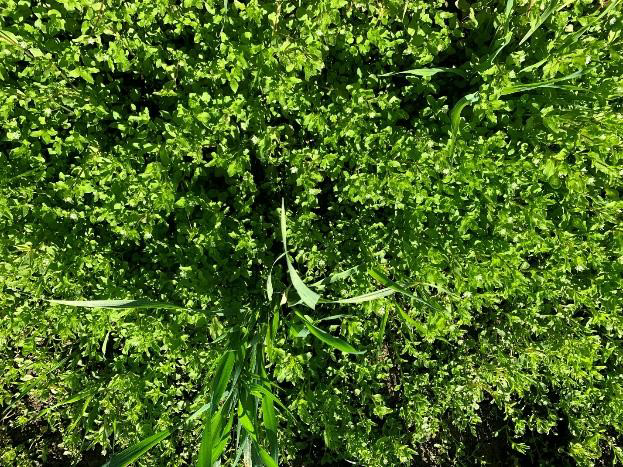
Herbicide resistance and ALS-inhibiting herbicides
Currently there are a total of 30 confirmed cases of herbicide resistance in California (Heap 2021), with most occurrences corresponding to single resistance to ALS- or EPSPS-inhibiting herbicides (Sosnoskie 2019).
Herbicides that target the enzyme acetolactate synthase (ALS) are notorious for their ability to select resistant (R) weed populations (Tranel and Wright 2017). It is the herbicide class with the greatest number of resistant weed species globally (Figure 4). Even more astounding fact is that the first ALS-inhibiting herbicide was commercialized in 1982, whereas other herbicide chemistries such as the triazines have been broadly used since 1960s (Tranel and Wright 2017). Although the main reasons for the high frequency of ALS inhibitors resistance cases are not fully understood, the genetics of ALS-inhibiting herbicide resistance (i.e., that resistance is conferred by a single, dominant, nuclear-encoded gene) has been suggested as one of the main factors (Tranel and Wright 2017).
Currently in California, seven weed species have been confirmed with single resistance to ALS-inhibiting herbicides (bensulfuron [five weed species] and sulfometuron [two weed species]), and one weed species has been confirmed with multiple resistance to imazamox (ALS-inhibitor) and other 3 SOAs (Heap 2021; Sosnoskie 2019).
Herbicide use patterns in CA cereal crops and common chickweed integrated management
One of the most important weed management strategies to delay the selection of herbicide-resistant weeds is the adoption of integrated weed management strategies with the use of multiple effective herbicide's sites of action (SOA); thus, one might ask “how diverse is the cereal crops herbicide program in California”? We analyzed the CA wheat, barley, triticale, oats and rye pesticide use reports (PURs) data, available at the California Pesticide Information Portal (CALPIP 2021), from 2015 to 2019 (Figure 5).
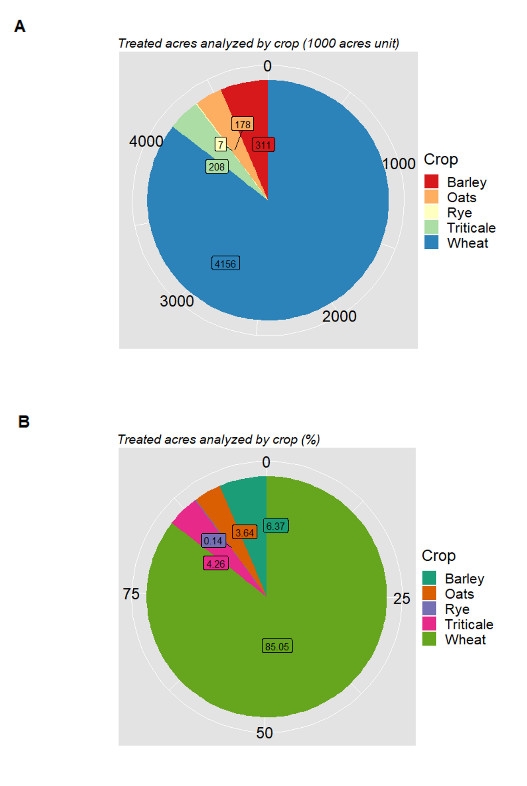
In summary, the main findings were:
- The most widely applied SOAs were ALS inhibitors (39.8% of all treated acres), synthetic auxin (28% of all treated acres) and PPO inhibitors (24% of all treated acres), respectively (Figure 6A).
- The five most applied active ingredients were tribenuron (20.3%; WSSA 2), carfentrazone (17.7%; WSSA 14), pyroxsulam (15.2%; WSSA 2), MCPA (14.9%; WSSA 4) and 2,4-D (6.7%; WSSA 4), respectively (Figure 6B).
- The most individually applied SOAs were also ALS inhibitors (37.8%), synthetic auxin (31.8%) and PPO inhibitors (17.7%) (Figure 7).
Based on these findings, a greater herbicide diversification and greater use of multiple effective SOAs would benefit CA cereal crops overall weed management program. The first step in the development of diversified herbicide use starts by knowing the chemical family and site of action to which an herbicide belongs. With that in mind, the “California Small Grains Herbicide Mode of Action Chart” in this article was created to help plan a diversified herbicide program. It lists all active ingredients labeled for use in small grain crops by site-of-action group, with a different number and color for each group. We also created a table (Table 2) to help in planning a more diversified common chickweed chemical control program. It lists all the herbicide options available for common chickweed control in cereal crops with their respective SOAs. Please, remember to always refer to the label for guidance as herbicide use and availability are crop specific.
Is herbicide resistance to blame?
It can be tempting to blame herbicide resistance for all cases of poor weed control with herbicides. However, several biotic and abiotic factors can also significantly impact herbicide effectiveness. Therefore, it is important to eliminate the following possible reasons that can lead to herbicide failure before assuming that surviving weeds are herbicide-resistant (PES 2021):
- Herbicide application related causes: poor spray coverage and/or incorporation, inadequate rate, improper timing of application of post-emergence herbicides (after weeds are too large to control), failure to use an adjuvant (if needed), excessive dust on leaf surface with post-emergence applications, “wrong herbicide” for the present weed spectrum, and possible antagonism between two or more herbicides.
- Soil and/or climatic conditions related causes: seedbed condition (clods, etc.), excessively wet or dry soil, herbicide adsorption to soil particles or organic matter, stress conditions (such as hot and dry), and lack of timely rainfall (or irrigation) for pre-emergent herbicides activation.
In addition to these steps, conducting a small herbicide efficacy trial is another helpful approach that can provide insight on the possibility of herbicide resistance. We established such a trial in a triticale field located in Tulare County. The treatments were applied at the late tillering stage of triticale and included pyroxsulam (Simplicity CA) and tribenuron (Express TotalSol) applied at 2X and 4X label rates (Figure 8). Visual estimates of common chickweed ground cover (or canopy) were taken 4 weeks after treatment (WAT). Results from this trial indicated that none of the treatments exhibited good activity on common chickweed, regardless of the rate (Figure 9). The only treatment that provided a significant reduction in common chickweed canopy, as compared to the untreated, was tribenuron at 4X label rate. However, it was only a 50% reduction which likely allowed treated plants to recover and survive.
UCCE future efforts
The lack of effective control using above-recommended label rates is concerning and an indicator that this common chickweed population might, indeed, be ALS-resistant; however, more robust studies are still necessary to confirm this possible new case of herbicide resistance. Common chickweed seeds were collected from the problematic fields (Figure 10) and dose-response bioassays will be conducted to test for herbicide resistance. Additionally, UCCE also plans to develop and conduct a series of integrated weed management studies looking at cultural practices such as sowing rate, sowing time, and row spacing in combination with chemical and mechanical weed control to prevent or delay the selection of herbicide-resistant weeds in cereal crops.
Extension collaborative work
Early identification of herbicide-resistant weed populations and corresponding changes to management tactics can reduce the spread and establishment of these biotypes. If you believe you have herbicide-resistant common chickweed populations in your small grains fields and would like to collaborate with us in this project, please complete this online survey: https://arcg.is/1nSCn51. Thanks!
Reference
California Pesticide Information Portal (CALPIP). (2021). California Department of Pesticide Regulation. CalPIP Application. Retrieved from https://calpip.cdpr.ca.gov/main.cfm
Canevari M, Orloff F, Vargas R, Wright S, Wilson R, Cudney D and Jackson L. (2006). Small grain production manual part 9. Pest management of small grains-weeds. Publication 8172. Retrieved from http://anrcatalog.ucanr.edu/pdf/8172.pdf
Heap, I. The International Herbicide-Resistant Weed Database. Online. Monday, July 26, 2021. Available www.weedscience.org Copyright © 1993- 2021 WeedScience.org All rights reserved. Fair use of this material is encouraged.
Khamare Y, Marble C, Boyd N, Steed S. (2019). Biology and Management of Common Chickweed (Stellaria media) in Ornamental Crop Production. UF/IFAS Mid-Florida Research and Education Center, Apopka (MREC). Retrieved from https://edis.ifas.ufl.edu /publication/EP577
Anonymous (2021). Common chickweed. Michigan State University [MSU] - Extension publication. Retrieved from https://www.canr.msu.edu/weeds/extension/common-chickweed
Pesticide Environment Stewardship [PES]. (2021). Is it Herbicide Resistance to Blame? Retrieved from https://pesticidestewardship.org/resistance/herbicide-resistance/is-herbicideresistance-to-blame-herbicide/
Sosnoskie L. (2019). The Current Status of Herbicide Resistance in California. UC Weed Science. Retrieved from https://ucanr.edu/blogs/blogcore/ postdetail.cfm?postnum=29069&#comments
Tranel PJ and Wright TR. (2002). Resistance of weeds to ALS-inhibiting herbicides: what have we learned? Weed Technology, 50, 700–712.
Wilen CA. (2006). Chickweed. Pest Notes University of California Agricultural and Natural Resources. Publication 74129. Retrieved from http://ipm.ucanr.edu/PMG/PESTNOTES/ pn74129.html
Author - Agronomy and Weed Management Advisor- Merced, San Joaquin and Stanislaus Counties.
Attached Files:



